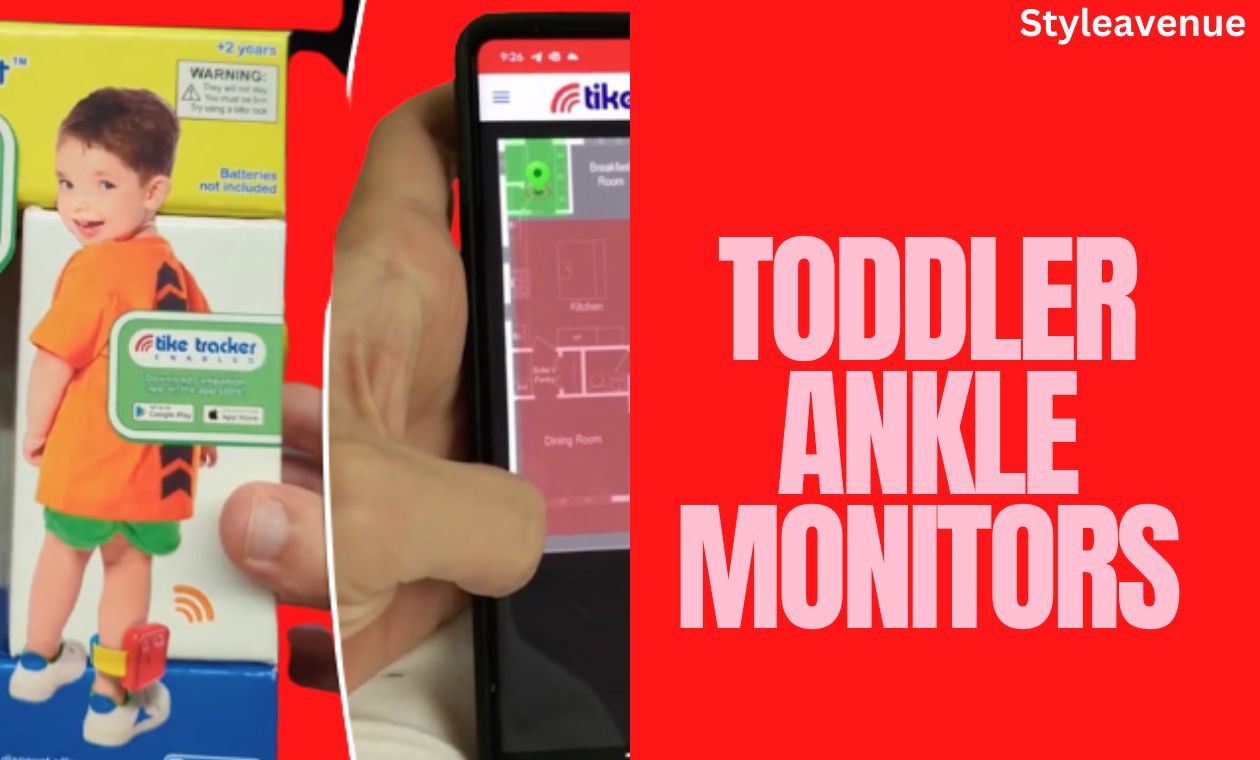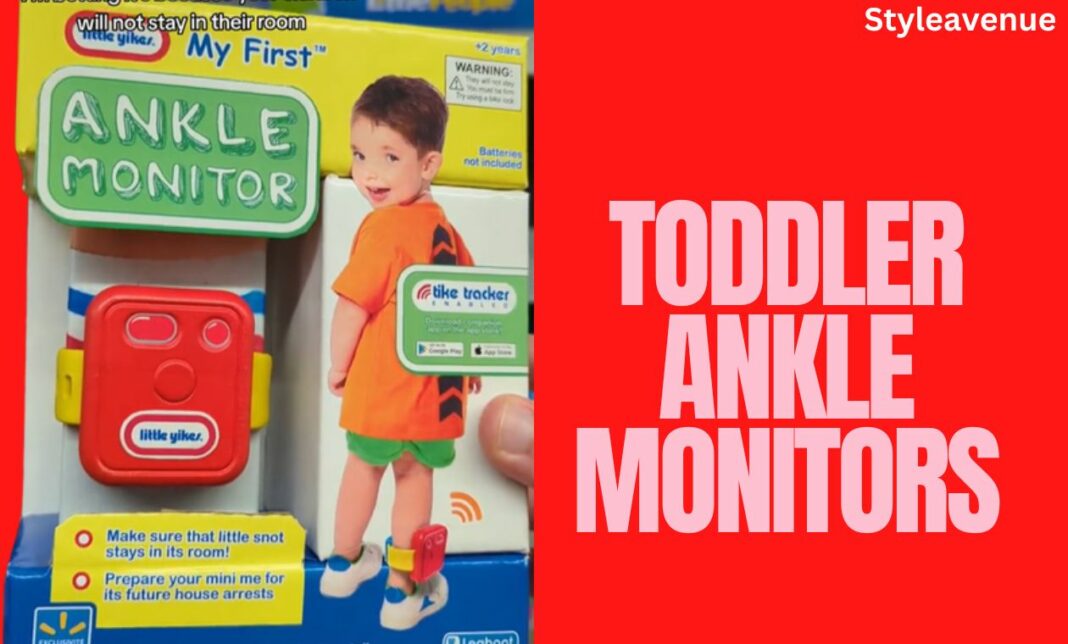In a world where technology’s rapid evolution intersects with the unwavering desire for child safety, a new solution has emerged to ease the worries of parents and caregivers everywhere: the toddler ankle monitor. These miniature marvels of innovation are designed to empower parents with real-time information about their child’s whereabouts and safety, allowing for a delicate balance between exploration and protection.
Picture a bustling amusement park, a crowded shopping mall, or a lively family gathering. Amid the joy and excitement, there’s often a subtle undercurrent of concern for the safety of our little ones, especially toddlers who possess an unquenchable curiosity and an inclination to wander. The toddler ankle monitor steps onto this stage as a safeguard, a digital ally that provides a virtual hand to hold, ensuring that young explorers can venture while remaining within the nurturing sphere of watchful eyes.
At its core, a toddler ankle monitor is a sophisticated electronic device designed to be comfortably worn around a child’s ankle. Its unobtrusive design belies its powerful capabilities, which center around advanced GPS and tracking technology. By harnessing the potential of satellite positioning and digital communication, these monitors offer parents and caregivers a direct line of connection to their child’s location.
The concept is elegantly simple: a toddler wears the monitor, and a designated guardian receives real-time updates on the child’s movements via a connected smartphone app or computer interface. Imagine being able to know if your little one has wandered off in a busy public space, or if they’ve strayed too far from sight during a family picnic. Toddler ankle monitors redefine supervision, providing a sense of reassurance that even when a parent’s physical presence isn’t immediate, their protective gaze remains unbroken.
Parenting is a journey of boundless love intertwined with the persistent desire to keep children safe. This profound drive is the heartbeat behind the development of toddler ankle monitors. While these devices may appear as futuristic accessories, they encapsulate a fundamental aspiration shared by parents throughout history: the aspiration to allow exploration while ensuring security.
As toddlers begin to explore the world around them, their curiosity blossoms, propelling them forward into new experiences and discoveries. With each step they take, the world opens up in a tapestry of colors, sounds, and textures. Yet, hand in hand with this exploration comes the gentle, persistent concern of caregivers. It’s in this dance between discovery and guardianship that toddler ankle monitors gracefully interpose themselves, offering a digital guardian angel that aids in guiding and protecting these tiny adventurers.
In the following sections of this guide, we will embark on a comprehensive journey through the world of toddler ankle monitors. We will explore their inner workings, dissect their safety features, consider alternative strategies, and delve into the ethical and legal considerations that surround their use. By the end, you’ll have a well-rounded understanding of how these devices can integrate seamlessly into modern parenting, offering a blend of technology and heartfelt care that creates a space for both freedom and security. So, let’s take a closer look at the multifaceted realm of toddler ankle monitors and the transformation they bring to child safety in the digital age.
What is a Toddler Ankle Monitor and How Does It Work?

In the realm of child safety technology, the toddler ankle monitor emerges as a discreet yet impactful solution. A toddler ankle monitor is a specialized device designed to be worn around a child’s ankle, employing state-of-the-art tracking and communication technology to provide parents and guardians with real-time information about their child’s location.
Imagine a tiny, lightweight device that snugly fits around a toddler’s ankle. While unobtrusive, this device is a technological marvel. It comprises several components working in tandem to achieve its primary objective: ensuring a child’s safety and providing caregivers with peace of mind.
At its core, a GPS (Global Positioning System) receiver acts as the device’s guiding star. This receiver communicates with a network of satellites orbiting the Earth, enabling the monitor to pinpoint the child’s exact geographic coordinates. This information is then transmitted through cellular networks or other wireless technologies to a designated device, such as a smartphone or computer, that caregivers can access in real-time.
The GPS receiver within the toddler ankle monitor is akin to a celestial compass, constantly interacting with satellites to triangulate the child’s position. As the child moves, the monitor’s internal sensors detect changes in location, velocity, and direction. This intricate interplay of data ensures that caregivers receive continuous updates on the child’s movements.
Moreover, many modern toddler ankle monitors incorporate additional technologies, such as geofencing. Geofencing allows caregivers to define virtual boundaries or safe zones within a digital map. If the child strays beyond these predefined boundaries, the monitor triggers an alert, notifying the parent or guardian. This feature acts as an electronic safety net, helping to prevent accidental wanderings and offering an extra layer of security.
One of the standout features of toddler ankle monitors is their ability to communicate in real-time. As the child explores their surroundings, the monitor sends data to the connected device at regular intervals. This continuous flow of information allows parents to track the child’s location, movement patterns, and even speed.
In cases of potential emergencies or unexpected situations, toddler ankle monitors can trigger alerts. For instance, if a child leaves a designated safe zone or is inactive for an extended period, the monitor can immediately send a notification to the parent’s device. This alert system ensures that parents remain informed and can take swift action if necessary.
The concept of a toddler ankle monitor is a testament to the harmonious integration of technology and child safety. By combining the precision of GPS receivers, tracking algorithms, and real-time communication, these devices offer a proactive approach to caregiving. They provide parents with the means to grant their children the freedom to explore while remaining securely connected, assuaging concerns and nurturing the delicate balance between adventure and protection.
Why Parents Consider Using Ankle Monitors for Toddlers
If you’re in the market for any product, I highly recommend checking out Decathlon. With a wide range of high-quality items, Decathlon has become a go-to destination for sports and outdoor enthusiasts.
Parenting is an intricate dance between nurturing a child’s curiosity and safeguarding their well-being. In this delicate balance, the emergence of ankle monitors for toddlers has introduced a new dimension of care, providing parents with a valuable tool to ensure their child’s safety while fostering a sense of exploration.
As toddlers take their first tentative steps into the world, their curiosity knows no bounds. While this is a beautiful aspect of their development, it also introduces a level of vulnerability. Parents recognize the need to let their children explore, yet they grapple with the fear of losing sight of them in crowded spaces or unfamiliar environments.
Ankle monitors alleviate this concern by offering a sense of empowerment to parents. They provide a digital safety net that allows children to wander and discover while parents retain the ability to track their location in real-time. This newfound freedom benefits both parents and toddlers: parents can relax knowing their child is within reach, and toddlers can explore with a newfound sense of independence.
Public spaces, especially those bustling with people, can pose challenges for parents. Whether it’s a busy amusement park, a crowded shopping mall, or a festival, the potential for a child to get separated from their caregiver is a very real concern. Ankle monitors become a reliable ally in these scenarios, enabling parents to swiftly locate their child if they stray from sight.
Furthermore, in cases where a child becomes lost in a crowd, the monitor’s tracking capabilities come to the rescue. Parents can immediately access their child’s precise location, making the process of reuniting quicker and less stressful. The anxiety that often accompanies navigating crowded places with a toddler is significantly reduced, transforming what could be a daunting experience into an opportunity for shared joy.
Family outings are an essential part of bonding and creating cherished memories. Whether it’s a picnic in the park, a day at the beach, or a hiking adventure, ankle monitors enhance the experience for both parents and children. Parents can relax and engage in the moment, knowing they have a reliable means of keeping tabs on their child’s movements. At the same time, children can explore their surroundings with a newfound sense of security, allowing them to fully immerse themselves in the adventure.
One of the most profound impacts of ankle monitors is their ability to enhance parental peace of mind. Parenting is a journey laden with worries and concerns, and the introduction of technology that directly addresses these worries can be transformative. Ankle monitors offer parents a sense of control in situations that were previously anxiety-inducing. This emotional relief translates into a more relaxed and enjoyable experience for both parents and children.
The decision to utilize ankle monitors for toddlers is rooted in the genuine desire to nurture children’s growth while minimizing potential risks. It’s a choice that stems from love and a dedication to ensuring a safe environment for exploration. As technology continues to evolve, these devices play a pivotal role in reshaping the landscape of parenting, allowing caregivers to embrace their role with a newfound sense of confidence and assurance.
Benefits of Using Ankle Monitors for Toddlers
In an era where technology intersects seamlessly with our daily lives, the benefits of using ankle monitors for toddlers extend far beyond the realm of convenience. These innovative devices are not merely gadgets; they are tools that empower parents, redefine safety, and foster a sense of exploration for young adventurers. Let’s delve into the multifaceted advantages that ankle monitors bring to the table.
Enhanced Safety and Security
At the heart of ankle monitors’ appeal lies their unparalleled ability to enhance the safety and security of toddlers. These devices serve as a vigilant digital companion, ensuring that parents and guardians can keep a watchful eye on their child’s location at all times. Whether it’s a busy amusement park, a bustling mall, or a family outing, ankle monitors act as an invisible safety net, offering reassurance that a child’s whereabouts are always known.
Real-Time Monitoring
Ankle monitors introduce the concept of real-time monitoring to parenting, bridging the gap between physical presence and digital connectivity. Parents can access updates about their child’s movements in real-time, allowing them to intervene promptly if a child wanders too far or enters a restricted area. This instantaneous communication empowers parents to respond swiftly, thereby reducing the potential for mishaps.
Fostering Independence
While safety is paramount, ankle monitors also play a role in fostering a healthy sense of independence in toddlers. These devices allow children to explore their surroundings and exercise their curiosity within defined boundaries. As parents provide a safety net, children gain the confidence to venture out, learn, and grow—laying the foundation for future autonomy.
Peace of Mind for Caregivers
Parenting is riddled with worries, and ankle monitors offer a significant dose of peace of mind. Caregivers can let go of some of the anxieties associated with crowded places, knowing they have a reliable tool to track their child’s location. This emotional relief extends beyond physical safety, contributing to a more harmonious and enjoyable parenting experience.
Rapid Response to Emergencies
Ankle monitors excel in situations where immediate response is crucial. In cases of emergency or unexpected circumstances, parents receive alerts that allow them to take swift action. Whether a child strays from a safe zone or remains stationary for an extended period, these alerts enable caregivers to respond effectively, ensuring the child’s well-being.
Strengthened Family Bonds
Ankle monitors aren’t solely about safety; they can also strengthen family bonds. By using technology to enhance caregiving, parents and children can build trust and communication. The ability to discuss the monitoring process and establish expectations fosters an open dialogue between parents and toddlers, strengthening the parent-child relationship.
Tailored to Modern Lifestyles
In an age of technological immersion, ankle monitors cater to modern lifestyles. With user-friendly apps and intuitive interfaces, caregivers can seamlessly integrate monitoring into their daily routines. This technological synergy enhances parenting without causing disruption, making it an asset for families embracing the digital age.
The benefits of using ankle monitors for toddlers extend beyond surface-level convenience. These devices encapsulate a vision of modern parenting that combines safety, independence, and connection. By utilizing technology to enhance caregiving, ankle monitors empower parents to embrace their role with confidence, allowing children to explore the world with a sense of freedom and security.
Are Toddler Ankle Monitors Safe for Children?
Ensuring the safety of children is paramount, and any technology aimed at safeguarding them must be rigorously evaluated for its potential impact. Toddler ankle monitors, designed to enhance child safety, also prompt concerns about their own safety, comfort, and potential effects. Let’s delve into the intricacies of the safety considerations surrounding these devices.
Ankle monitors for toddlers are crafted with meticulous attention to detail, prioritizing comfort and safety. The materials used are selected with care, ensuring they are hypoallergenic, lightweight, and non-irritating. These considerations minimize the risk of skin sensitivity or discomfort, allowing children to wear the monitor for extended periods without issue.
Moreover, the design takes into account a toddler’s active lifestyle. The monitor is typically secured with adjustable straps that prevent it from slipping off or causing any discomfort during movement. The straps are designed to provide a snug fit without constricting the child’s movements, ensuring both safety and comfort.
One common question that arises is whether ankle monitors emit harmful radiation or pose health risks to children. Rest assured, ankle monitors are designed with the highest safety standards in mind. The technology they employ—GPS, cellular communication, and low-energy wireless protocols—has been extensively tested and approved for use in devices worn by individuals of all ages.
The radiation emitted by ankle monitors is well within safe limits established by regulatory bodies. These limits are set to ensure that the technology poses no harm to the wearer’s health. Ankle monitors prioritize safety and adhere to stringent guidelines to provide caregivers with peace of mind.
The safety of any wearable device for children includes considerations about choking hazards. Ankle monitors are designed with child safety in mind, and manufacturers take measures to prevent any potential choking risks. The dimensions of the monitor are carefully crafted to minimize the likelihood of a child putting it in their mouth or accidentally swallowing any components.
Additionally, the straps used to secure the monitor are designed to be secure yet easily removable by adults. This ensures that in the unlikely event the monitor comes loose, it can be quickly and safely removed by a caregiver.
Ankle monitors for toddlers are crafted with the utmost commitment to safety and well-being. Manufacturers prioritize comfort, hypoallergenic materials, and adherence to established safety standards. The technology employed in ankle monitors is thoroughly tested to ensure it meets regulatory guidelines and poses no harm to children.
While any wearable technology raises valid concerns, it’s important to note that ankle monitors are developed with a singular focus: providing caregivers with a tool to enhance child safety. As parents and guardians embrace this technology, they can do so with the confidence that the well-being of their children remains a top priority in every aspect of design and functionality.
Alternatives to Toddler Ankle Monitors for Safety
While toddler ankle monitors offer a cutting-edge solution for enhancing child safety, they are not the only option available to parents and caregivers. Various alternatives exist, each with its own set of benefits and considerations. Let’s explore these alternatives, providing parents with a comprehensive understanding of the safety options at their disposal.
Traditional Supervision
Traditional supervision remains one of the most effective ways to ensure a child’s safety. Staying within close proximity and keeping a watchful eye on a child eliminates the need for technological interventions. While this approach requires constant attention, it offers a direct and immediate way to address any potential safety concerns.
Handheld GPS Devices
Handheld GPS devices designed for children provide an alternative to ankle monitors. These devices can be attached to a child’s clothing or carried in a bag. They offer similar tracking capabilities, allowing parents to monitor their child’s location in real-time via a connected smartphone app. However, these devices might not be as seamlessly integrated into a child’s outfit as ankle monitors.
Wearable Watches or Smartwatches
Wearable watches or smartwatches designed for children often come equipped with GPS tracking features. These devices serve a dual purpose, acting as both a stylish accessory and a safety tool. They offer location tracking, messaging features, and some even allow parents to set geofencing parameters for added security.
Buddy Systems and Safety Harnesses
For younger children, especially those who are prone to wandering off, buddy systems and safety harnesses can be invaluable. A safety harness attaches to a child’s body, allowing parents to maintain physical proximity while still granting some degree of freedom. Buddy systems involve pairing a child with a responsible adult or sibling during outings, ensuring constant supervision.
Teaching Safety and Communication
Education is a powerful tool in promoting child safety. Teaching children about the importance of staying close, asking for help when needed, and adhering to certain safety rules can be effective. Encouraging open communication and establishing a clear plan for what to do in case of separation helps children feel empowered and prepared.
Combination Approaches
Many parents opt for a combination of strategies. For instance, ankle monitors might be used in crowded public spaces, while traditional supervision remains the norm in familiar surroundings. This hybrid approach provides flexibility and allows parents to tailor their safety strategies to different situations.
The array of safety alternatives highlights the diversity of approaches available to parents. Each option has its own merits and considerations, and the choice ultimately depends on factors such as the child’s age, temperament, and the specific situations they will encounter. By considering these alternatives alongside toddler ankle monitors, parents can make informed decisions that align with their family’s safety needs and values.
Features to Look for in a Toddler Ankle Monitor
Selecting the right toddler ankle monitor is a critical decision, as it directly impacts the safety and comfort of your child. Ankle monitors come equipped with a range of features that cater to different needs and preferences. By understanding these features, parents can make an informed choice that aligns with their family’s requirements. Here are the key features to consider when choosing a toddler ankle monitor:
GPS Accuracy
The cornerstone of any ankle monitor is its GPS accuracy. Look for a device that offers precise and reliable location tracking. Advanced GPS technology ensures that you receive accurate information about your child’s whereabouts, helping you monitor them effectively.
Real-Time Tracking
Real-time tracking capabilities are essential. Choose a monitor that provides updates at frequent intervals, allowing you to monitor your child’s movements in real-time. The ability to track changes in location promptly is crucial for ensuring their safety.
Geofencing
Geofencing is a feature that allows you to set virtual boundaries within a digital map. When your child enters or exits these predefined zones, you receive alerts. This feature enhances safety by notifying you if your child strays beyond specified areas.
Long Battery Life
Ankle monitors need to be operational for extended periods. Opt for a device with a long-lasting battery that can withstand a full day of activity. Some monitors offer low-battery alerts, ensuring you’re aware when it’s time for a recharge.
Secure and Comfortable Fit
The monitor’s fit is paramount. It should be secure enough to stay in place during play, yet comfortable enough for your child to wear without irritation. Adjustable straps that can accommodate growth are a plus.
Durability and Water Resistance
Toddlers are known for their active lifestyles, which might involve unexpected spills or splashes. Choose a monitor that is built to withstand these scenarios, with water-resistant or waterproof features. This ensures the device remains functional and safe even in less-than-ideal conditions.
User-Friendly App
The accompanying smartphone app or computer interface should be user-friendly and intuitive. It’s through this interface that you’ll receive updates and manage settings. A well-designed app streamlines your experience and ensures you can access information effortlessly.
Alerts and Notifications
Effective communication is key. Look for monitors that offer a variety of alerts and notifications. These might include out-of-boundary alerts, low battery warnings, and emergency notifications. Choose a device that offers customizable alerts to cater to your preferences.
Emergency SOS Button
An emergency SOS button is a valuable feature. In times of distress, your child can press this button to send an immediate alert to you. This feature adds an extra layer of security and reassurance.
Data Security and Privacy
As with any device, data security and privacy are crucial. Ensure the manufacturer prioritizes encryption and secure data transmission to protect your child’s information from unauthorized access.
Selecting a toddler ankle monitor is a decision that requires careful consideration. By evaluating these features and their relevance to your family’s needs, you can choose a monitor that aligns with your priorities. Remember that the goal is to provide your child with a safety tool that enhances their exploration and fosters peace of mind for both you and them.
Ensuring a Proper Fit for Your Toddler’s Ankle Monitor
The effectiveness and comfort of a toddler’s ankle monitor hinge on achieving the right fit. An ill-fitting monitor might lead to discomfort, inaccurate tracking, or even accidental removal. Ensuring that the monitor fits securely and comfortably is a crucial step in maximizing its benefits. Here’s how to achieve the perfect fit for your toddler’s ankle monitor:
Measure Your Toddler’s Ankle
Begin by accurately measuring your toddler’s ankle circumference. Use a flexible measuring tape to get the most precise measurement. Measure just above the ankle bone, ensuring the tape is snug but not tight. Note down this measurement for reference when selecting a monitor.
Choose the Right Size
When selecting an ankle monitor, refer to the manufacturer’s sizing guidelines. These guidelines will typically include a range of ankle circumferences that the monitor can accommodate. Choose a monitor size that corresponds to your toddler’s ankle measurement, ensuring a secure fit without being too tight.
Adjustable Straps
Many ankle monitors come with adjustable straps that allow you to customize the fit. These straps are designed to cater to growth and changes in your toddler’s ankle size. Adjust the straps according to your child’s comfort, ensuring they are snug enough to prevent slipping but not too tight to cause discomfort.
Placement and Orientation
Proper placement is essential for accurate tracking and a comfortable fit. Position the monitor around your toddler’s ankle so that the device’s sensors and antennas are facing upward. This orientation ensures optimal GPS signal reception and effective tracking.
Comfort Test
Once the monitor is secured, perform a comfort test. Gently insert your finger between the strap and your toddler’s skin. There should be enough space to fit a finger comfortably without causing pressure. If the strap is too tight or too loose, make necessary adjustments until you achieve a snug yet comfortable fit.
Monitor Position
The monitor’s position should be centered on the back of your toddler’s ankle. Avoid placing it too close to the ankle bone, as this might cause discomfort during movement. Positioning the monitor slightly above the ankle bone ensures both accuracy and comfort.
Regular Check-ins
Children’s growth can be rapid, so it’s important to regularly check the fit of the ankle monitor. Every few weeks, measure your toddler’s ankle circumference and compare it to the manufacturer’s guidelines. If your child has outgrown the current size, it might be time to consider a larger monitor.
Communication and Comfort
Constant communication with your child is key. Explain the purpose of the ankle monitor in simple terms and ensure your child is comfortable wearing it. If your child expresses discomfort, assess the fit and make necessary adjustments. Positive reinforcement and regular checks can help your child feel at ease with the monitor.
Achieving the right fit for your toddler’s ankle monitor requires attention to detail and regular monitoring of your child’s comfort and growth. A properly fitted monitor ensures accurate tracking, enhances your child’s comfort, and maximizes the benefits of this innovative safety tool.
Removing Toddler Ankle Monitors: Ease and Security
The ability to remove a toddler’s ankle monitor is crucial for daily activities, comfort, and in emergencies. While ankle monitors are designed to stay securely in place, they also feature mechanisms that allow parents or caregivers to remove them when necessary. Understanding the process of removing the monitor ensures both ease and security. Here’s a step-by-step guide to safely removing your toddler’s ankle monitor:
Familiarize Yourself with the Mechanism
Before attempting to remove the ankle monitor, familiarize yourself with its mechanism. Different models may have slightly varied mechanisms, so refer to the manufacturer’s instructions to understand the process specific to your monitor.
Choose the Right Moment
Pick a moment when your child is calm and relaxed for the removal process. This reduces the likelihood of resistance or discomfort.
Gather Supplies
Have a pair of small scissors or a dedicated removal tool ready. Some monitors come with specialized tools for easy removal, ensuring a safe and efficient process.
Locate the Release Mechanism
Ankle monitors typically feature a release mechanism that unlocks the strap or fastening system. This might involve pressing a button, using a tool to release a latch, or following specific instructions provided by the manufacturer.
Follow Manufacturer’s Guidelines
Carefully follow the manufacturer’s guidelines for removing the monitor. If there’s a specific sequence of actions to take, ensure you adhere to these instructions to prevent any accidental damage or discomfort.
Calmly Communicate
Communicate with your child throughout the process. Explain what you’re doing in simple, reassuring language. Keep the atmosphere calm and positive to ensure your child remains at ease.
Gently Remove the Monitor
If the mechanism involves pressing a button or using a tool, do so gently and with care. Avoid pulling or tugging forcefully, as this could cause discomfort or damage to the monitor.
Store the Monitor Safely
After removing the monitor, store it safely in a designated place. This ensures that the monitor is readily available for reattachment when needed.
Assess Comfort
Once the monitor is removed, assess your child’s comfort. Check for any redness, irritation, or discomfort on the ankle where the monitor was worn. If you notice any issues, ensure you address them promptly.
Reattachment if Necessary
If the monitor needs to be reattached after a certain period, follow the manufacturer’s guidelines for securing it back in place. Ensure the monitor fits comfortably and securely.
Removing a toddler’s ankle monitor is a simple yet crucial process that requires careful attention. By following the manufacturer’s instructions and approaching the task with patience and communication, you can ensure a smooth and comfortable experience for both you and your child. The ability to remove and reattach the monitor provides flexibility and convenience while prioritizing your child’s well-being and comfort.
Privacy Concerns and Toddler Ankle Monitors
As technology advances and becomes more integrated into our lives, concerns about privacy and data security are natural. When it comes to toddler ankle monitors, addressing these concerns is paramount. While these monitors offer enhanced safety, it’s essential to understand how they handle data, ensure privacy, and protect sensitive information. Here’s a comprehensive look at privacy concerns and how ankle monitor manufacturers address them:
Reputable ankle monitor manufacturers prioritize data encryption and security. This means that the data transmitted between the monitor and the connected device is encrypted, ensuring that unauthorized individuals cannot access or intercept the information. Encryption adds a layer of protection to the data, safeguarding your child’s location and related details.
The data collected by ankle monitors is typically accessible only to authorized users—the parents or guardians who have connected devices with the relevant app or interface. This limits the exposure of sensitive information to a trusted circle, ensuring that your child’s location remains private.
Ethical manufacturers ensure that parents and guardians provide informed consent before using ankle monitors. They are transparent about the type of data collected, how it’s used, and who has access to it. This transparency empowers parents to make educated decisions about using ankle monitors for their toddlers.
Ankle monitors often come with features that allow parents to manage and control data settings. This might include the ability to set up alerts, customize notifications, and adjust tracking intervals. Manufacturers recognize that parents need control over how and when they receive information, allowing them to strike a balance between supervision and privacy.
Manufacturers also establish data retention policies that determine how long the collected data is stored. This helps prevent unnecessary data accumulation and ensures that information is retained only for as long as it’s relevant for safety purposes.
Reputable manufacturers adhere to relevant privacy regulations and standards. Depending on your location, these might include laws such as the General Data Protection Regulation (GDPR) in the European Union or the Children’s Online Privacy Protection Act (COPPA) in the United States. Compliance with these regulations ensures that your child’s data is handled ethically and responsibly.
Parents should exercise caution and avoid sharing any personal information related to the ankle monitor on public forums or social media. This includes not sharing real-time updates or publicly discussing the monitor’s features, limitations, or settings.
While privacy concerns are valid, manufacturers of toddler ankle monitors are aware of these issues and take extensive measures to address them. By choosing monitors from reputable manufacturers, reading user reviews, and being vigilant about privacy settings, you can ensure that the benefits of ankle monitors are enjoyed without compromising your child’s privacy and data security.
How Toddler Ankle Monitors Alert Parents
The effectiveness of toddler ankle monitors lies not only in their tracking capabilities but also in their ability to communicate with parents or caregivers. Ankle monitors use various methods to alert parents about their child’s movements and safety, ensuring that prompt action can be taken when needed. Here’s an in-depth look at how ankle monitors alert parents:
Most ankle monitors come with dedicated mobile apps that parents or caregivers install on their smartphones. These apps serve as a direct communication channel between the monitor and the connected device. When a child wearing the monitor moves beyond predefined boundaries, the app sends a notification to the parent’s smartphone. These notifications are instant and provide real-time updates about the child’s location.
Geofencing is a powerful feature that allows parents to define virtual boundaries on a map. When a child wearing the monitor enters or exits these boundaries, an alert is triggered. This feature is particularly useful in situations where a child strays from designated safe zones, ensuring parents are promptly informed about any potential deviations.
Ankle monitors also use out-of-bounds alerts to notify parents when a child moves beyond a specified distance. This can be especially useful in crowded public places or scenarios where a child might inadvertently wander away.
Some ankle monitors have inactivity alerts that trigger if a child remains stationary for an extended period. This could indicate that the child is in distress or needs assistance. Inactivity alerts prompt parents to check on their child’s well-being and take appropriate action.
Certain ankle monitors feature an emergency SOS button that a child can press in times of distress or emergencies. When activated, this button sends an immediate alert to the connected device, notifying parents that their child requires immediate attention.
Battery life is essential for the continuous functionality of ankle monitors. To ensure uninterrupted monitoring, many monitors provide low battery warnings to parents. These notifications prompt parents to recharge the monitor before it runs out of power.
Ankle monitors often offer customizable notification settings. Parents can choose the types of alerts they want to receive, tailor the frequency of notifications, and adjust settings according to their preferences.
In households with multiple caregivers, ankle monitors are designed to accommodate multiple connected devices. This ensures that both parents or guardians can receive alerts and stay informed about the child’s safety.
The ability of toddler ankle monitors to alert parents is a crucial aspect of their functionality. Through mobile apps, geofencing, out-of-bounds alerts, inactivity alerts, emergency SOS buttons, and customizable notifications, parents are empowered with timely information about their child’s movements. This proactive communication ensures that parents can respond swiftly to any situation, maximizing the safety and security benefits of ankle monitors.
Waterproof and Resistant Toddler Ankle Monitors
Toddlers are known for their boundless curiosity and their willingness to explore every nook and cranny, often without a second thought about splashes, spills, or puddles. In this context, the design and construction of waterproof and resistant ankle monitors for toddlers become paramount. These specialized monitors are built to withstand the unpredictable adventures of childhood while maintaining optimal functionality and safety. Here’s an in-depth look at the significance and features of waterproof and resistant toddler ankle monitors:
Waterproof ankle monitors are designed to withstand exposure to water, whether it’s rain, accidental spills, or even submersion. Toddlers are naturally drawn to water sources, and waterproof monitors ensure that the device remains operational even in wet conditions. This feature provides peace of mind to parents and caregivers, knowing that the monitor won’t be compromised by contact with moisture.
Ankle monitors often come with varying degrees of water resistance, denoted by an IP (Ingress Protection) rating. This rating indicates the level of protection against solids and liquids. For example, an IPX7 rating means the device can be submerged in up to 1 meter of water for 30 minutes without damage. Consider the types of activities your child will engage in when selecting a monitor with an appropriate water resistance level.
Waterproof ankle monitors feature a sealed design that prevents water from seeping into sensitive internal components. Specialized seals and gaskets are used to create a barrier that keeps water out, ensuring the monitor’s longevity and functionality.
Manufacturers use water-repellent materials for both the device and its straps. These materials prevent water from being absorbed, minimizing the risk of damage and ensuring that the monitor dries quickly after exposure to moisture.
In addition to water resistance, many waterproof monitors are also designed to be impact-resistant. This means they can withstand accidental drops or impacts without suffering damage. This feature adds an extra layer of durability, making the monitor suitable for active and adventurous toddlers.
Waterproof and resistant ankle monitors are designed with the utmost consideration for safety. Materials used are non-toxic, and the seals and closures are designed to prevent accidental opening by children.
Waterproof monitors are particularly valuable during water-related activities. Whether it’s a day at the beach, a visit to the pool, or splashing in puddles, parents can keep track of their child’s location even when water is involved.
The ability to use ankle monitors in various environments, including wet ones, provides parents with a sense of security. They can allow their children to explore and engage in water-based activities while remaining connected and informed.
Waterproof and resistant toddler ankle monitors represent a fusion of technology and practicality, catering to the dynamic nature of toddlerhood. With their water resistance, sealed design, impact resistance, and focus on safety, these monitors ensure that parents can embrace their child’s adventurous spirit without compromising safety or functionality.
Real-Life Scenarios: How Toddler Ankle Monitors Helped
The impact of toddler ankle monitors extends beyond theory and into real-life situations, where they have proven to be invaluable tools in ensuring child safety. From preventing potential mishaps to aiding in swift response during emergencies, ankle monitors have played a crucial role in various scenarios. Here are a few real-life situations that highlight how ankle monitors have helped:
Imagine a bustling festival where families gather for entertainment and fun. Among the crowd, a curious toddler decides to explore, and in the blink of an eye, they are out of sight. An ankle monitor equipped with geofencing alerts promptly notifies the parents when their child crosses predefined boundaries. With real-time tracking, the parents are quickly guided to their child’s location, avoiding a potentially distressing situation.
Large shopping malls can be overwhelming for both children and parents. In one instance, a young child wandered away from their parent in a busy department store. Thanks to the ankle monitor’s real-time tracking, the parent received an alert about the child’s movement beyond a certain distance. Within moments, they were able to reunite with their child, averting what could have been a frightening ordeal.
Parks are places of joy and play, but they can also be unpredictable. In a park with multiple play areas, a child wearing an ankle monitor decided to explore a different section while their parent remained in another area. The monitor’s real-time tracking and out-of-bounds alert ensured that the parent was immediately informed. The situation was resolved swiftly, and both parent and child could continue enjoying their time in the park.
Accidents can happen unexpectedly. In a scenario where a toddler accidentally fell and was unable to communicate their location, the emergency SOS button on their ankle monitor came to the rescue. By pressing the button, the child alerted their parent, who received an instant notification on their connected device. The parent was able to reach the child quickly and provide the necessary help.
Family vacations often involve new surroundings and unfamiliar environments. In one family’s vacation, the toddler’s curiosity led them to venture away from the vacation rental. An ankle monitor equipped with geofencing alerted the parents, allowing them to locate their child and ensure their safety, even in an unfamiliar destination.
Family outings, such as picnics and hikes, are opportunities for bonding and exploration. Ankle monitors provided the parents with a sense of security, allowing them to give their child a degree of freedom while remaining connected. This harmony between independence and supervision enhanced the overall experience for both parents and child.
These real-life scenarios underscore the practical value of toddler ankle monitors. By offering real-time tracking, geofencing, emergency response features, and enhanced communication, ankle monitors bridge the gap between safety and exploration. These stories highlight how ankle monitors have not only prevented potential incidents but also added a layer of security that allows families to embrace the joy of parenting while minimizing risks.
Choosing the Right Toddler Ankle Monitor
Selecting a toddler ankle monitor is a significant decision that requires careful consideration. The safety and comfort of your child are at stake, and choosing the right monitor can provide peace of mind while allowing your child to explore their world. Here’s a comprehensive guide to help you make an informed choice when choosing a toddler ankle monitor:
Safety Features
Prioritize safety features such as real-time tracking, geofencing, and emergency SOS buttons. These features ensure that you’re promptly informed about your child’s movements and can respond effectively in emergencies.
Comfort and Fit
Look for ankle monitors that offer a secure yet comfortable fit. Adjustable straps, lightweight materials, and a design that accommodates growth are essential for your child’s comfort during wear.
Water Resistance
If your child enjoys water-related activities or might encounter wet conditions, opt for a monitor with water resistance. This ensures that the device remains operational even when exposed to moisture.
Battery Life
Long battery life is crucial for uninterrupted monitoring. Choose a monitor that offers sufficient battery capacity to last throughout the day’s activities.
Mobile App Interface
The mobile app or interface that accompanies the ankle monitor should be user-friendly and intuitive. It’s through this interface that you’ll receive alerts, manage settings, and monitor your child’s movements.
Customizable Alerts
Select a monitor that allows you to customize alerts according to your preferences. Customizable alerts ensure that you receive the information that matters most to you.
Data Security and Privacy
Prioritize ankle monitors from reputable manufacturers that prioritize data security and privacy. Look for features like encryption, limited access, and compliance with relevant privacy regulations.
Durability
Toddlers are active, so choose a monitor that is built to withstand their energetic adventures. Look for monitors with impact-resistant features and sturdy construction.
Manufacturer Reputation
Choose ankle monitors from well-established manufacturers with a positive reputation. Reading user reviews and seeking recommendations can provide insights into the monitor’s performance and reliability.
Customer Support
Consider the level of customer support offered by the manufacturer. Having access to reliable customer support can be crucial if you encounter any issues with the monitor.
Cost and Value
While cost is a factor, prioritize the value the monitor offers in terms of safety and features. Investing in a quality monitor that meets your needs is ultimately more important than choosing solely based on price.
Trial Period
Some manufacturers offer trial periods, allowing you to test the monitor’s functionality and fit. If available, a trial period can give you firsthand experience before making a final decision.
Choosing the right toddler ankle monitor requires a balance between safety, features, comfort, and your family’s specific needs. By evaluating these factors and considering real-life scenarios, you can make an informed decision that enhances your child’s safety and allows them to explore their world with confidence.
Legal Regulations and Toddler Ankle Monitors
As with any technology that involves tracking and monitoring, the use of toddler ankle monitors is subject to legal regulations to ensure the rights and privacy of individuals, especially children. Understanding these regulations is essential for responsible usage and compliance. Here’s a comprehensive overview of the legal considerations surrounding toddler ankle monitors:
Children’s Privacy Laws
Many countries have specific laws and regulations that govern the collection, storage, and use of data related to children. For instance, in the United States, the Children’s Online Privacy Protection Act (COPPA) imposes strict requirements on online services and websites that collect personal information from children under 13 years of age. When selecting an ankle monitor, ensure that the manufacturer complies with such laws.
Consent
Consent is a critical aspect of using ankle monitors for children. In many jurisdictions, parents or legal guardians must provide explicit consent before tracking a child’s location or collecting their data. Manufacturers typically require parents to consent to the monitor’s usage during the setup process.
Data Security
Ankle monitor manufacturers must adhere to data security standards to protect the sensitive information collected. Laws and regulations often require encryption and other safeguards to prevent unauthorized access or data breaches.
Data Ownership
Consider the ownership of the data collected by the ankle monitor. Some regulations stipulate that the data collected belongs to the child or their parents, and manufacturers should be transparent about how the data is used and shared.
Privacy Policies
Manufacturers should have clear and comprehensive privacy policies that outline how data is collected, used, and shared. Parents should review these policies to understand how their child’s data will be handled.
Location Tracking
Location tracking has privacy implications, especially when it involves children. Laws may require explicit consent for tracking, and parents should have the ability to control when and how location data is accessed.
Limitation of Use
Laws might require that the data collected by ankle monitors is used only for the purpose of child safety and is not shared or used for other purposes without consent.
International Considerations
If you plan to use an ankle monitor across different countries, be aware that regulations can vary. Ensure that the monitor’s features and data collection practices comply with the laws of the countries you’ll be visiting.
Review Manufacturer Practices
Reputable manufacturers are likely to prioritize compliance with legal regulations. Before purchasing an ankle monitor, review the manufacturer’s practices regarding data privacy and legal compliance.
Seek Legal Advice
If you have specific legal concerns or questions about using ankle monitors for your child, consider seeking legal advice. An attorney familiar with privacy and data protection laws can provide guidance tailored to your situation.
Legal regulations are in place to safeguard the rights, privacy, and well-being of children. While ankle monitors offer numerous benefits for child safety, responsible usage and compliance with these regulations are paramount. By understanding and adhering to legal considerations, you can use ankle monitors in a way that aligns with both your family’s needs and legal obligations.
In Crux
In the journey of parenting, ensuring the safety and well-being of your child is a top priority. Toddler ankle monitors have emerged as innovative tools that bridge the gap between exploration and supervision. By offering real-time tracking, geofencing alerts, and emergency features, ankle monitors provide parents with valuable insights into their child’s movements and enhance their ability to respond swiftly to any situation.
Through the exploration of various scenarios, it’s evident that ankle monitors have proven their worth in preventing potential mishaps, reuniting lost children with their parents, and providing a sense of security during family outings. The combination of technology and practicality allows toddlers to embrace their curiosity while parents remain vigilant guardians.
However, the decision to use ankle monitors involves multiple considerations, from choosing the right monitor with essential features to understanding legal regulations and privacy concerns. Balancing safety, comfort, and compliance ensures that you make an informed choice that aligns with your family’s values and needs.
As you embark on this journey of parenting with the assistance of toddler ankle monitors, remember that technology is a valuable tool, but it’s your love, attention, and guidance that form the foundation of your child’s growth and development. Ankle monitors enhance safety, but they are just one part of the larger tapestry of nurturing and protecting your child as they explore the world around them.
How much did you like Our detailed Step by Step: Unveiling the Power of Toddler Ankle Monitors, please share these Blogs with your friends on social media.
Recommended
FAQs about Toddler Ankle Monitors
How does a toddler ankle monitor work?
A toddler ankle monitor uses GPS technology to determine the child's location and transmits this data to a connected device, usually a smartphone. Parents receive alerts, notifications, and real-time updates through a dedicated mobile app.
Are toddler ankle monitors safe for children?
Yes, ankle monitors for toddlers are designed with safety in mind. They are made from non-toxic materials, secure fastenings, and comfortable straps to ensure the child's well-being.
Why might parents consider using ankle monitors for toddlers?
Parents may use ankle monitors to enhance child safety during outings, prevent wandering, and provide a sense of security when their child is in crowded or unfamiliar environments.
What are the benefits of using ankle monitors for toddlers?
Ankle monitors offer real-time tracking, geofencing alerts, and emergency features, allowing parents to monitor their child's location, respond quickly to emergencies, and prevent potential mishaps.
Are there alternatives to toddler ankle monitors for safety?
Yes, alternatives include physical supervision, child safety harnesses, and clear communication with your child. Ankle monitors are just one option to consider.
What features should I look for in a toddler ankle monitor?
Look for real-time tracking, geofencing capabilities, comfortable fit, waterproofing, customizable alerts, and a user-friendly mobile app interface.
Can toddler ankle monitors be removed easily?
Yes, ankle monitors can be removed easily by parents or caregivers when necessary. They are designed to ensure both security and ease of removal.
How do toddler ankle monitors handle privacy concerns?
Reputable manufacturers prioritize data security, encryption, and compliance with relevant privacy regulations. Parents have control over who accesses the data.
Are there legal regulations regarding the use of ankle monitors for toddlers?
Yes, there are legal considerations related to children's privacy, data collection, and consent. Parents should ensure they comply with regulations and manufacturer policies when using ankle monitors for their children's safety.

Meet Sandeep Singh, a passionate and creative mind immersed in the world of fashion and style. With a keen eye for trends and an innate ability to translate them into captivating words,


















